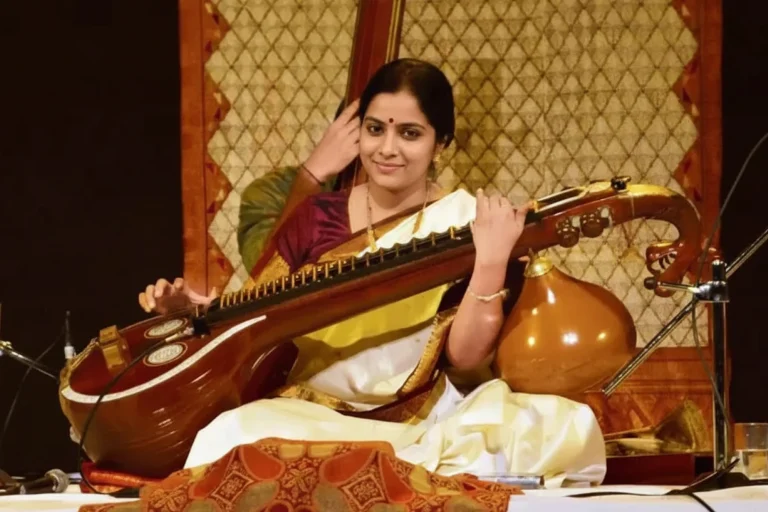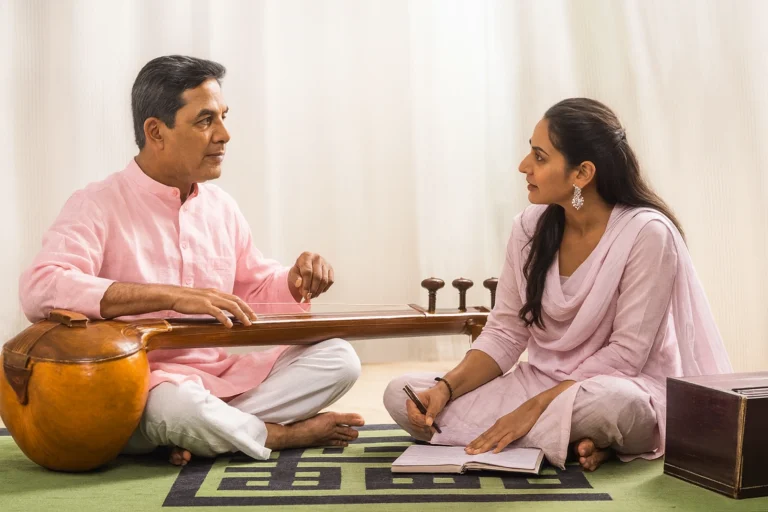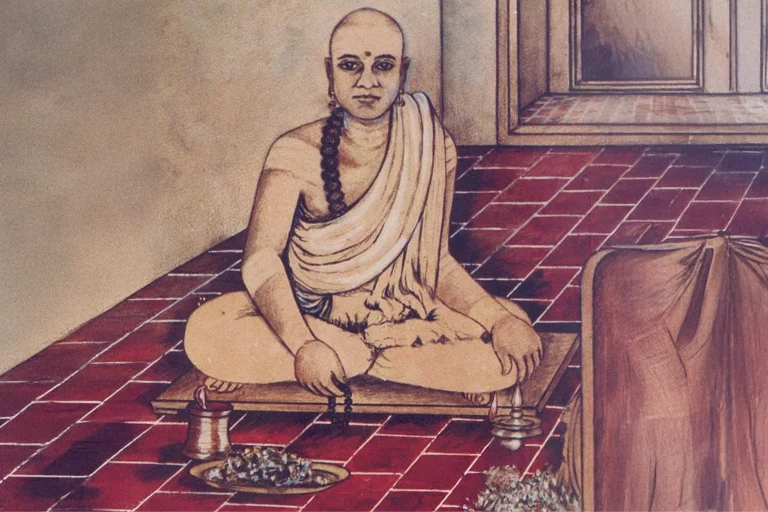All Topics
- Alchemizing Music Concepts for Students
- Artist Spotlight
- artium gift card
- Artium Maestros
- Artium News
- buying guide
- Carnatic Music
- Devotional Music
- Editorials by Ananth Vaidyanathan
- Film Music
- Guitar
- Hindustani Classical Music
- Indian Classical Music
- Indian Folk Music
- Insights
- Instruments
- Karaoke Singing
- Keyboard
- Kids Music
- maestros
- Music Education
- Music for Kids
- Music Industry
- Music Instruments
- Music Legends
- Music Theory
- Music Therapy
- Piano
- piano guide
- Success Stories
- Tamil Film Music
- Telugu Film Music
- Time Theory
- Tools
- Uncategorized
- Vocal Singing
- Vocals
- western classical music
- western music
- Western vocal music
The Concept of Adi Talam (Ādi Tāla) in Carnatic Music
The Concept of Adi Talam (Ādi Tāla) in Carnatic Music
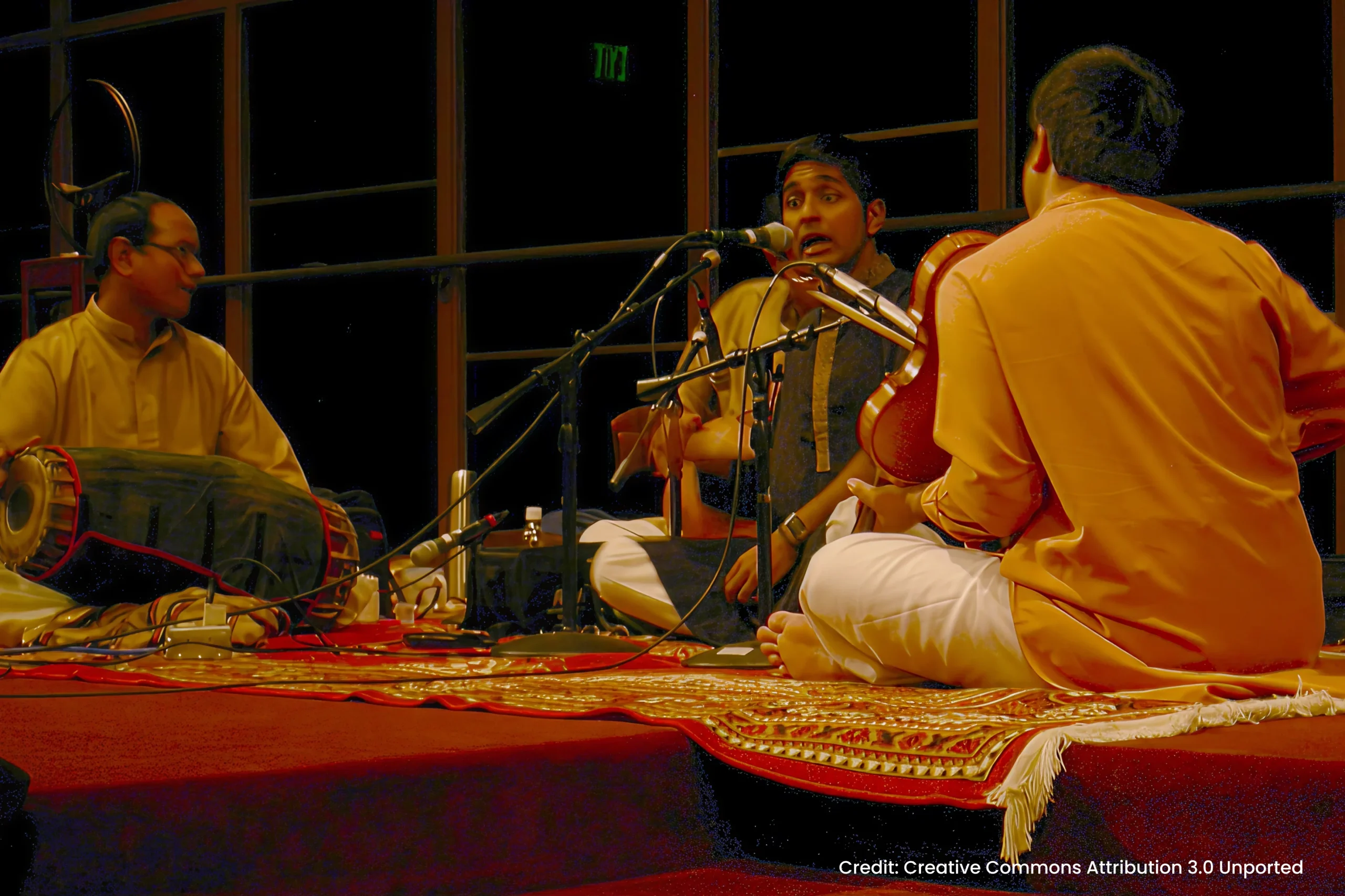
Table of Contents
In Carnatic music, Laya is not just a sense of timing; it is the pulse that breathes life into melody. Without rhythm, even the most beautiful raga loses its coherence and impact. The Tāla system provides this rhythmic structure, acting as an invisible thread that weaves together musical phrases, lyrical syllables, and emotional expression. It creates symmetry and balance, ensuring that every composition flows with purpose and grace.
Among the many rhythmic cycles, Adi Talam holds a special place. Its eight-beat structure offers simplicity for beginners and endless possibilities for improvisation for seasoned artists. From basic lessons like Alankarams to advanced Kritis and Ragam-Tanam-Pallavis, Ādi Tāla forms the rhythmic foundation that musicians return to time and again.
Through online carnatic music classes, students learn to internalize Ādi Tāla, mastering basic lessons like Alankarams and advanced compositions. Ādi Tālam forms the rhythmic foundation that musicians return to time and again. It embodies the essence of discipline and creativity, teaching students to feel rhythm intuitively while exploring an infinite range of patterns within its framework.
Understanding Tālam: The Rhythmic Framework
In Carnatic music, Tāla or Talam refers to a cyclical framework that regulates time in music. Each Tāla has a fixed number of beats (aksharas), divided into smaller rhythmic units called Angas. Every Tāla creates a unique rhythmic character, determining how musical phrases are composed and rendered.
Tāla is not merely a meter; it is an expressive framework that allows for mathematical creativity (Laya Kattus), intricate improvisations (Tani Āvartanam), and aesthetic alignment with the melodic and lyrical flow.
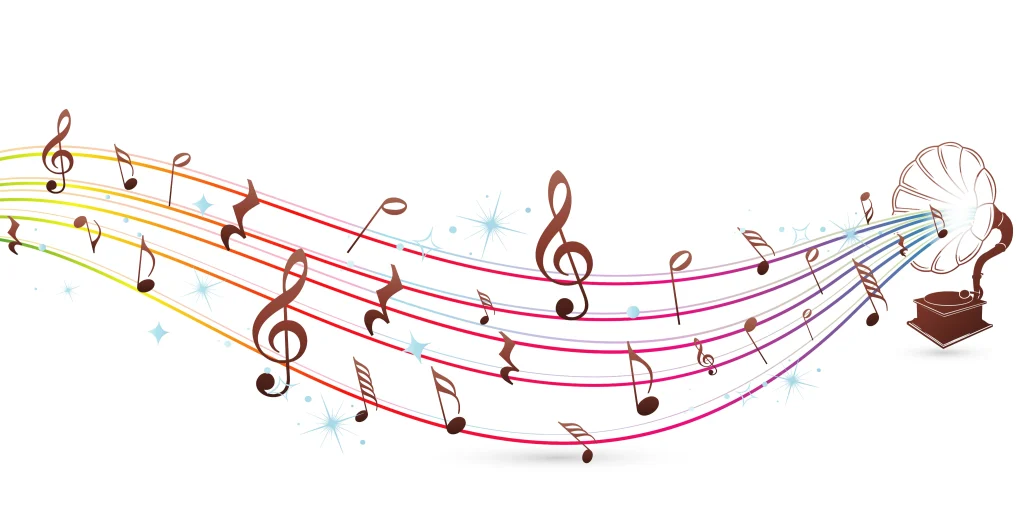
What is the Meaning of Ādi Talam?
The term Ādi, meaning “beginning” or “foundation,” perfectly captures the essence of this Tāla in Carnatic classical music. As the Chatusra-jāti Tripuṭa Tāla, it serves as the cornerstone for countless compositions, guiding students from their very first lessons through advanced concert performances. Its structure, consisting of one laghu (4 beats) and two dhrutams (2 beats each), creates an eight-beat rhythmic cycle that is both simple and versatile.
This balanced framework enables musicians to explore rhythm creatively while maintaining precision, making Ādi Tāla the ideal rhythmic form for both learners and seasoned performers.
Watch this to know more about Thalams and Adi Talam-
Structure of Ādi Tālam
Ādi Tāla consists of 8 beats (aksharas), arranged in the following pattern. Here’s a clear table format for the structure of Ādi Tāla:
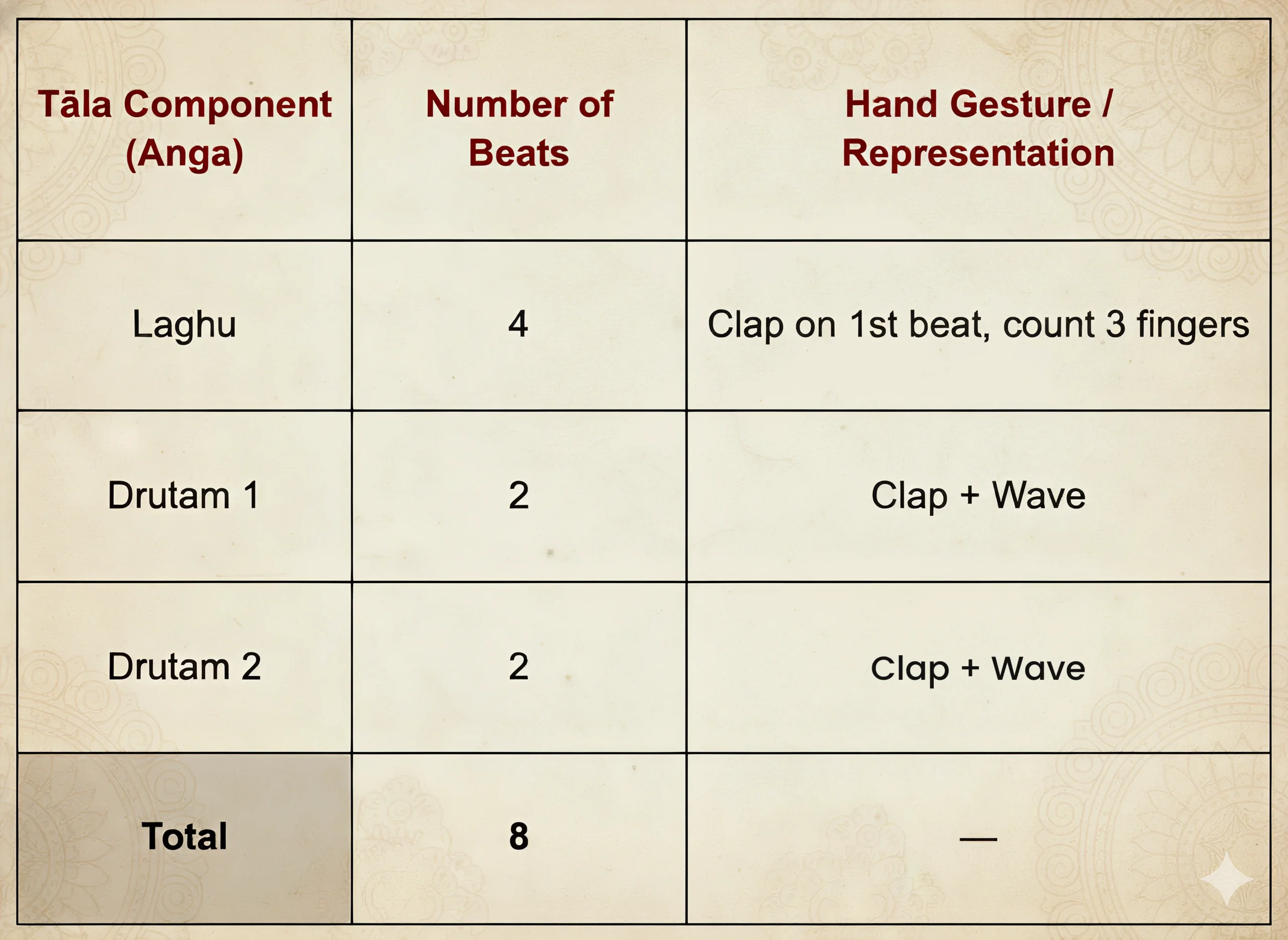
This table visually represents the Chatusra-jāti Tripuṭa Tāla structure used in Carnatic music.
Introducing the Three Angas of Adi Tālam
Each Tāla is composed of different Angas, which define its internal structure. The Angas are specific hand movements that help performers and students keep time.
Let’s explore the three Angas that form Ādi Tālam:
1. Laghu (I)
The Laghu is a rhythmic unit that varies in length depending on the Jāti (type). In Chatusra-jāti, the Laghu has 4 beats.
Hand Action:
- Beat once on the thigh (count 1)
- Show the next 3 counts with the fingers sequentially (count 2, 3, 4)
Mnemonic Count:
Ta – Ka – Dhi – Mi (each syllable representing one beat)
Thus, the Laghu in Ādi Tāla takes 4 beats.
2. Dhrutam (0)
The Dhrutam is a shorter Anga consisting of 2 beats.
Hand Action:
- Beat once on the thigh (count 1)
- Turn the palm upward (count 2)
Mnemonic Count: Ta – Ka
3. The Second Dhrutam (0)
Similar to the first, another 2-beat Dhrutam follows.
Hand Action: Beat once and turn the palm once again.
Total Counts:
- Laghu = 4 beats
- First Dhrutam = 2 beats
- Second Dhrutam = 2 beats
→ Total = 8 beats
Hence, Ādi Tāla = I 0 0 = 4 + 2 + 2 = 8 beats
Understanding Jāti and the Chatusra System
Every Tāla family (such as Tripuṭa, Jhampa, or Ata) can have different Jātis, changing the number of beats in the Laghu.
There are five Jātis:
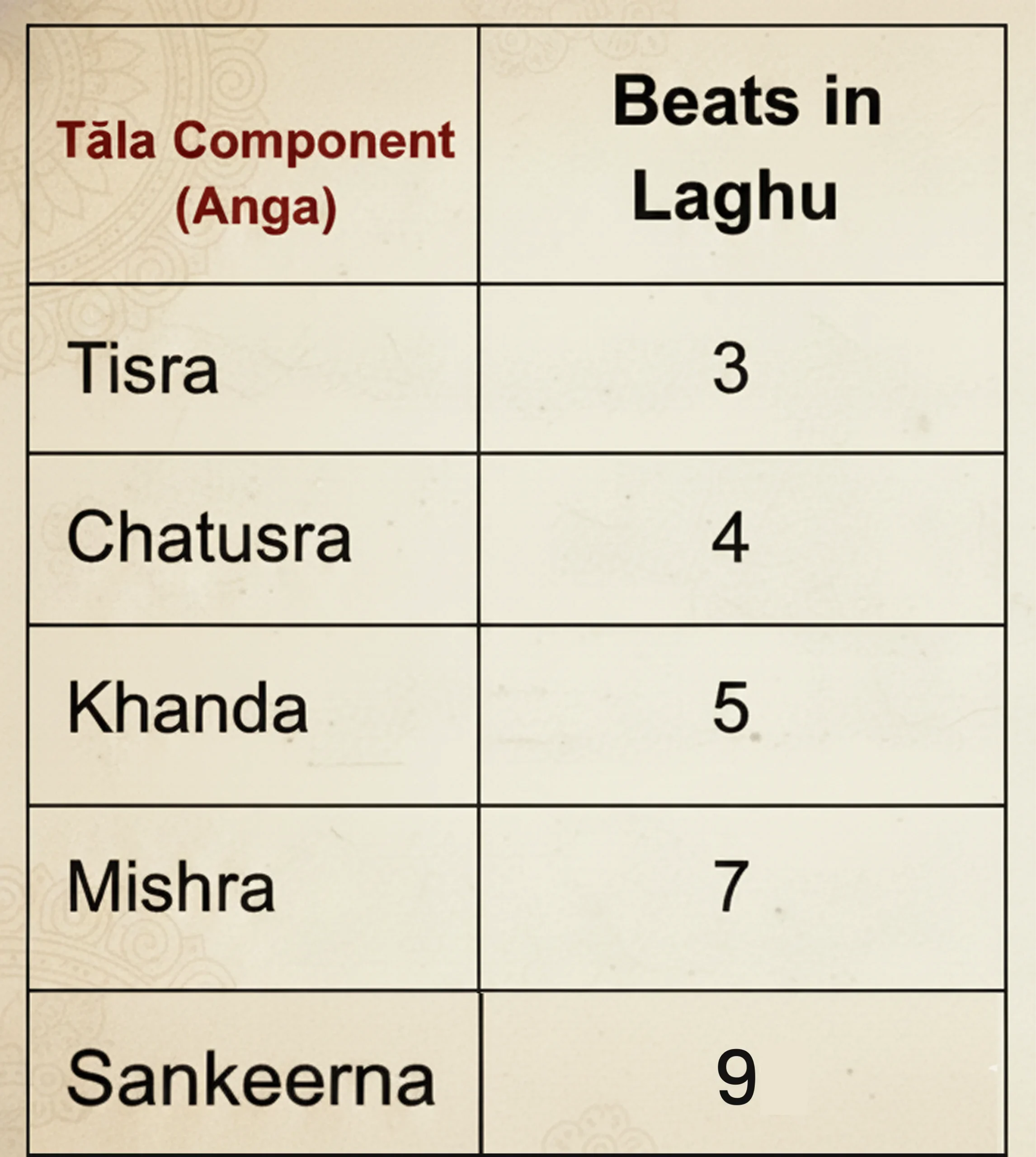
Ādi Tāla belongs explicitly to the Chatusra-jāti, where the Laghu has 4 beats. That’s why it is correctly called: Chatusra-jāti Tripuṭa Tāla (Ādi Tāla).
Why is Ādi Tālam So Popular?
- Simplicity: With 8 beats, it is easy to grasp and synchronize with compositions.
- Symmetry: The even division (4 + 2 + 2) offers a balanced rhythmic feel.
- Flexibility: It can accommodate compositions of various speeds (kalams) and rhythmic subdivisions (nadai).
- Universality: Many of the foundational exercises—Alankarams, Geetams, Varnams, and even Kritis—are set in Ādi Tāla.
- Gateway to Laya Understanding: It serves as the starting point for learning about Laya (tempo), Nadai (subdivision), and rhythmic improvisations.
Watch is to know more about Sapta Talas and Adi Tala in Carnatic Music System:
Understanding the Concept of Samam and Arudi
In Carnatic music, Samam is the first beat of a tālam and serves as the anchor where the composition and rhythm cycle meet. It provides a point of resolution and balance, guiding both the performer and listener through the rhythmic structure. Arudi, on the other hand, is a point of emphasis, often placed just before the Samam in complex pallavis or rhythmic improvisations.
It creates anticipation and highlights musical phrases, adding depth to the performance. Understanding Samam and Arudi helps learners internalize rhythm, execute compositions accurately, and express the subtle interplay between melody and tāla with precision.
Example: Rendering Ādi Tāla with Syllables
Let’s see how the 8-beat cycle looks when counted with rhythmic syllables (solkattu):
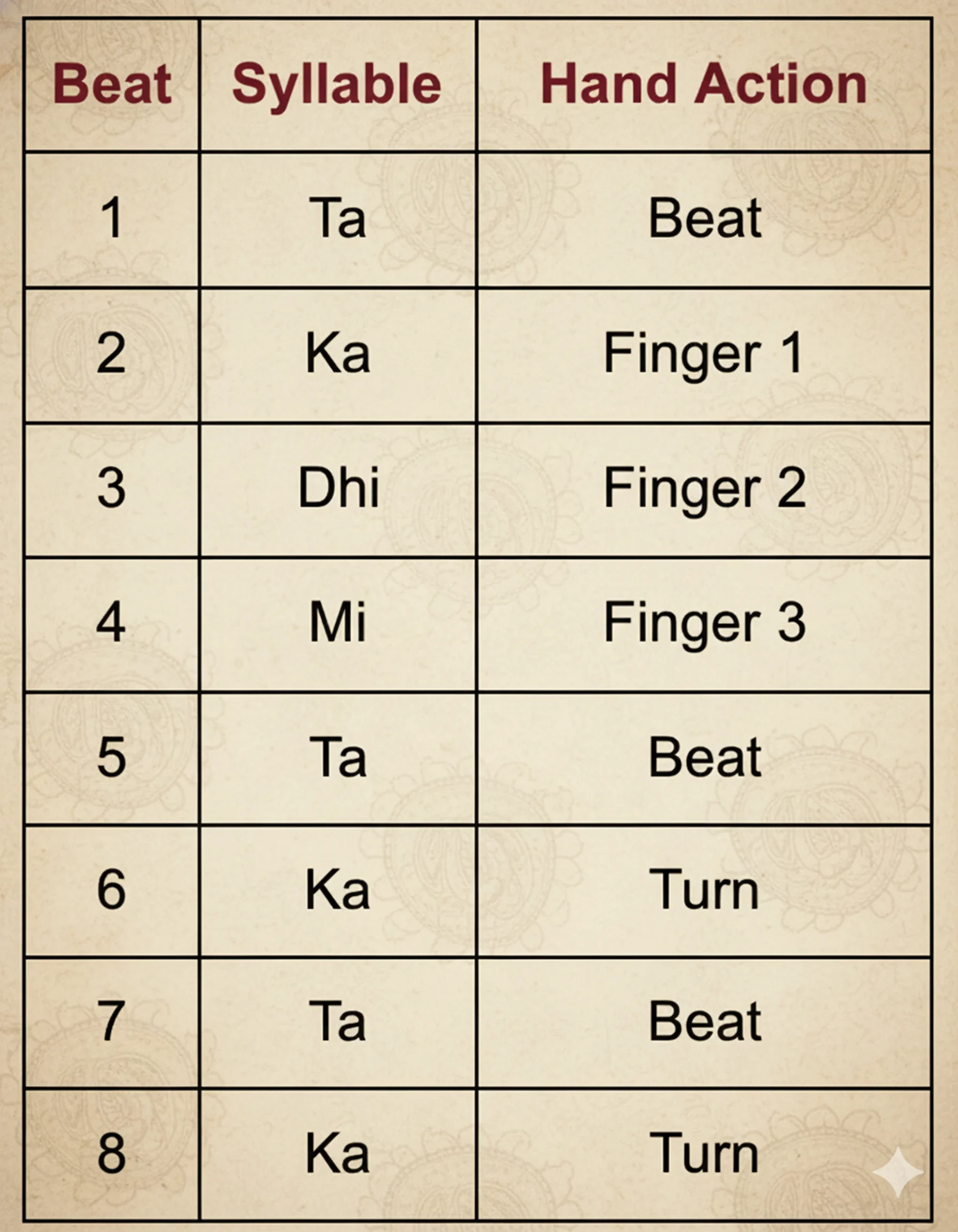
So, the rhythmic pattern becomes: Ta-Ka-Dhi-Mi Ta-Ka Ta-Ka. This is the simplest and most commonly practiced pattern for beginners.
Janta and Dhatu Varisais
In Carnatic music training, Janta Varisais emphasize repetition and stress, where notes are repeated to strengthen precision, clarity, and control. Dhatu Varisai’s focus on leaps or jumps between notes enhances agility and flexibility in navigating the raga. Both exercises are practiced within the strict 8-beat framework, ensuring rhythmic discipline.
A key aspect is aligning the end of each varisai pattern with the Samam, the first beat of the tālam, which develops a strong sense of timing and coordination. Mastery of Janta and Dhatu Varisais builds a solid foundation for improvisation and performance accuracy in Carnatic music.
Understanding Nāḍai (Gait or Subdivision)
Nāḍai refers to how each beat (akshara) of the Tāla is subdivided. In Ādi Tāla, while the structure remains 8 beats, the internal subdivision can vary.
Common Nāḍais are:
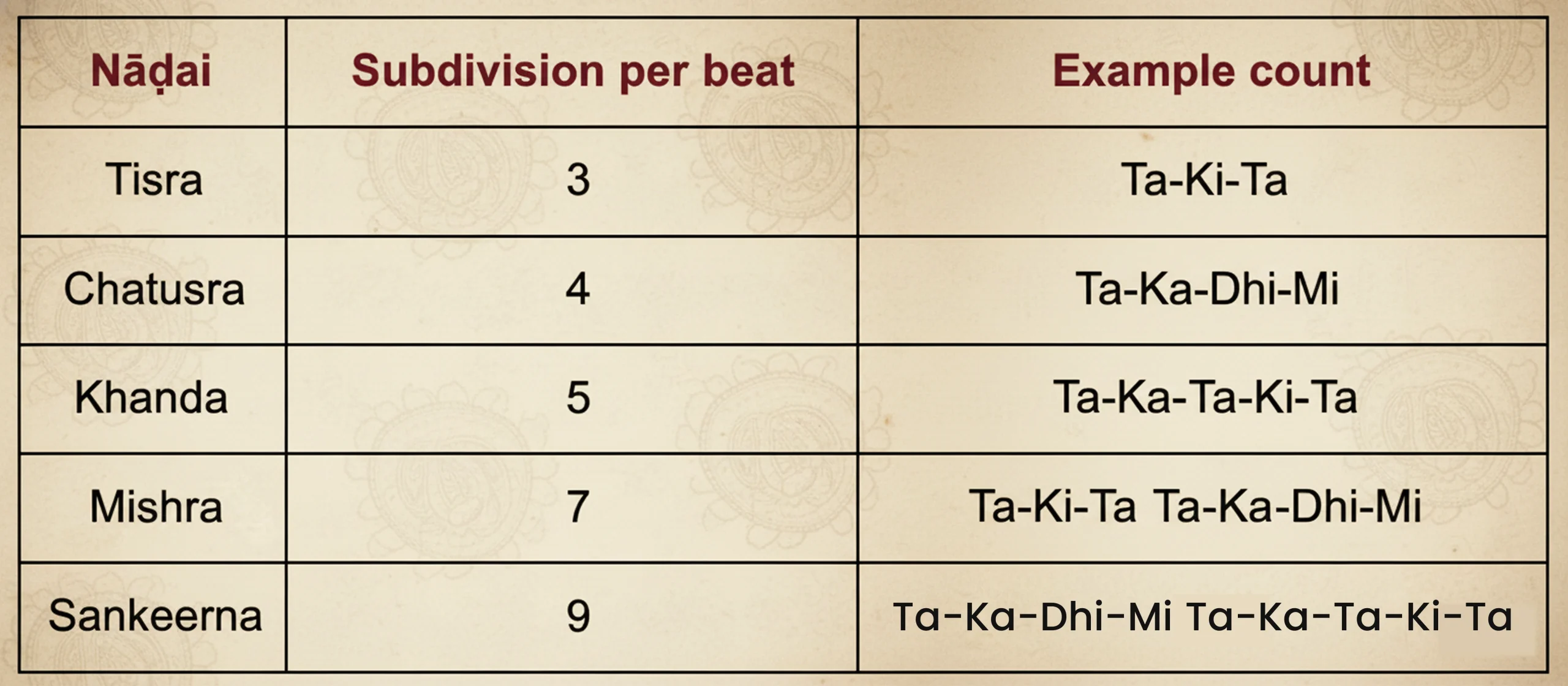
So, even within the same 8-beat Ādi Tāla framework, the rhythm can sound completely different depending on the Nāḍai.
Ādi Tālam in Practice
1. In Basic Exercises (Alankarams):
Students first learn to render Swaras in different Tālas. Ādi Tāla is most often used for these Alankarams, helping students internalize the sense of rhythm.
For example: S R G M | R G M P | G M P D | M P D N ||
When sung in Ādi Tāla, every note is aligned with a beat, teaching synchronization and timing.
2. In Geethams and Varnams:
Composers like Purandaradasa and Adi Shankaracharya have set many simple Geethams in Ādi Tāla. Examples include:
- “Kereya Neeranu” (Raga: Malahari)
- “Sree Gananatha” (Raga: Malahari)
- “Lambodara Lakumikara” (Raga: Malahari)
These pieces use Ādi Tāla to establish rhythmic steadiness in early learning stages.
3. In Kritis:
Many masterpieces of the Trinity of Carnatic Music—Tyagaraja, Muthuswami Dikshitar, and Syama Sastri—are set in Ādi Tāla.
For example:
- “Endaro Mahanubhavulu” (Raga: Sri, Tyagaraja)
- “Vatapi Ganapatim” (Raga: Hamsadhwani, Muthuswami Dikshitar)
- “Brochevarevarura” (Raga: Khamas, Mysore Vasudevachar)
These demonstrate how even complex compositions can comfortably flow within the simple symmetry of Ādi Tāla.
Mathematical Beauty of Ādi Tālam
The beauty of Ādi Tāla lies in its mathematical precision and creative potential. Musicians use it for rhythmic improvisation (Tani Āvartanam)—a showcase of mastery over Laya.
For instance, advanced percussionists may divide the 8 beats into intricate subgroups (like 5 + 3, 3 + 3 + 2, etc.), creating Korvais (mathematical patterns) that always resolve perfectly back to the beginning of the cycle (Samam).
Ādi Tālam and Speed (Kālam)
Students learn to perform at multiple speeds:
- First speed: One note per beat
- Second speed: Two notes per beat
- Third speed: Four notes per beat
This develops precision, control, and rhythmic fluency. The clarity of the Ādi Tāla structure makes it ideal for mastering multiple kālams.
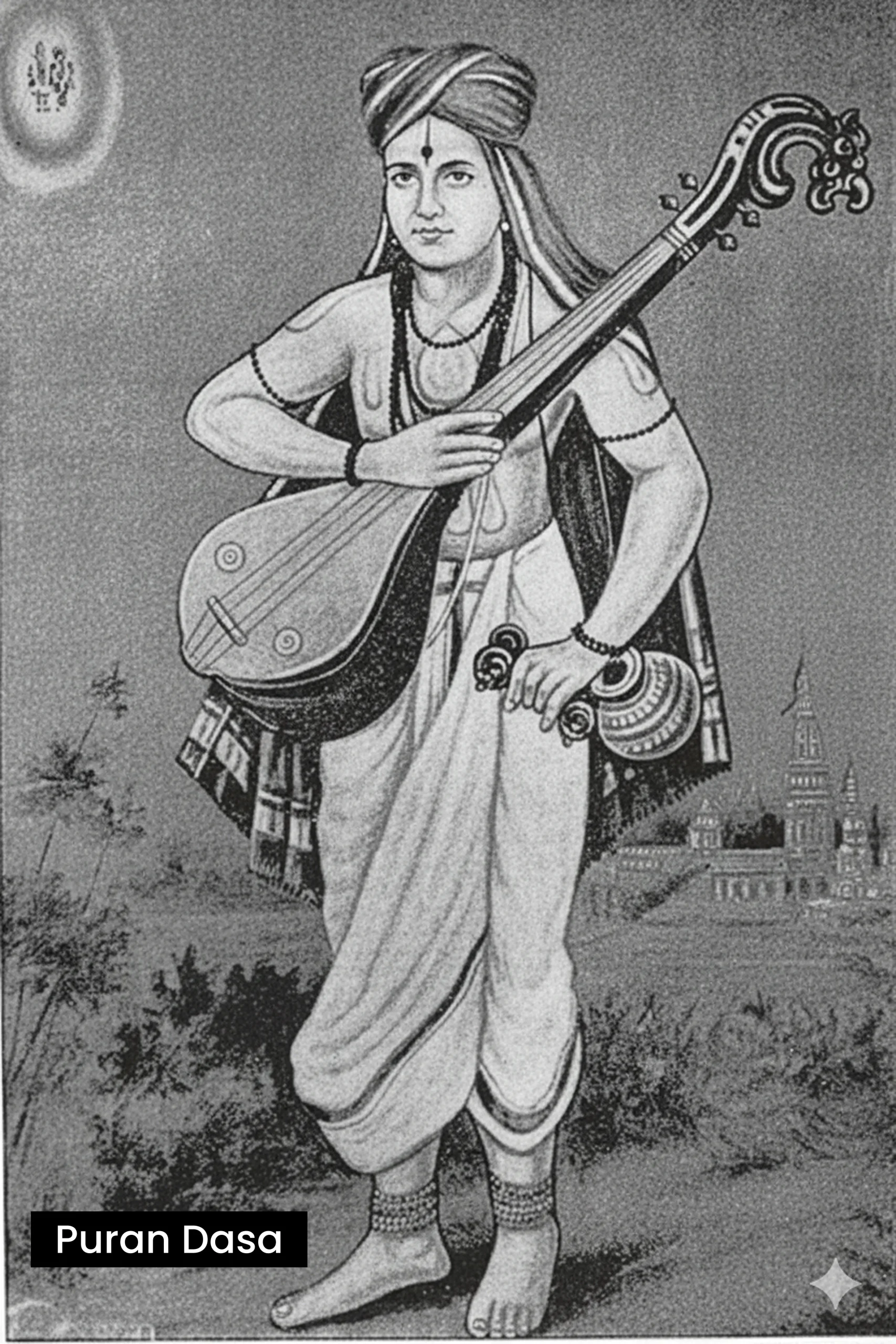
What is Ragam-Tanam-Pallavi?
Ragam-Tanam-Pallavi (RTP) is a cornerstone of advanced Carnatic music, showcasing a musician’s mastery over melody, rhythm, and improvisation. Ragam is the melodic exploration of a raga without rhythm, allowing the artist to elaborate on its mood and nuances. Tanam introduces a rhythmic pulse without lyrical content, combining melody and rhythm in a flowing, dynamic pattern.
Pallavi is a single-line thematic composition set to a specific tāla or talam, which the performer develops through intricate improvisations, including swara patterns, rhythmic variations, and creative interpretations. RTP cultivates improvisational skills, deepens understanding of tāla, and demonstrates the seamless integration of laya and raga in performance.
Application to Carnatic Vocals and Instrumental Practice
In both vocal and instrumental practice, maintaining Ādi Tāla accuracy is crucial when performing alankāras and ragam exercises. Consistently aligning phrases with the 8-beat cycle ensures rhythmic precision and enhances musicality. Practitioners are encouraged to internalize the tāla rather than depend solely on hand gestures or counting aloud.
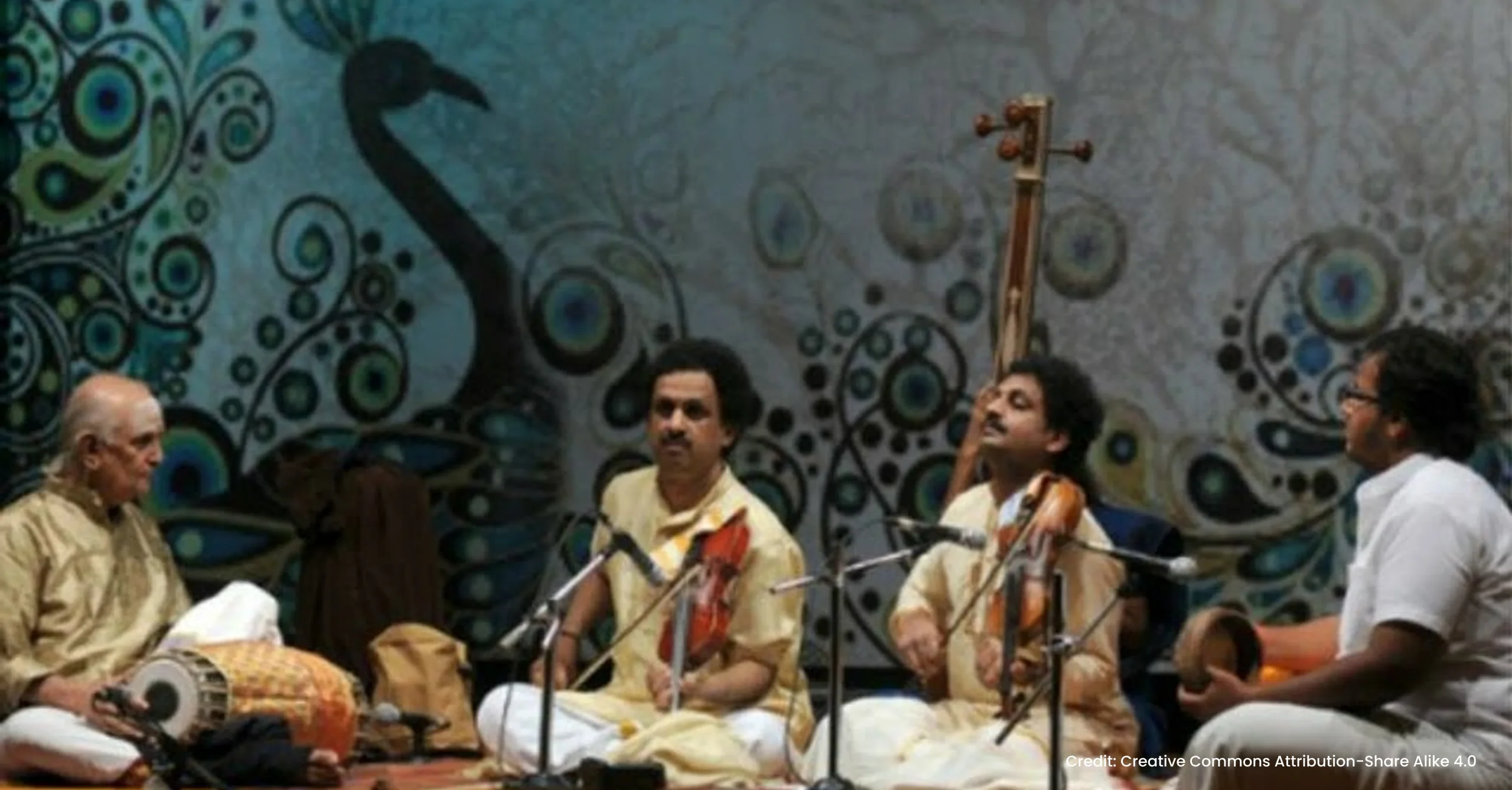
This internal sense of rhythm allows smoother execution of complex patterns, improves timing in improvisation, and fosters confidence during performance. Over time, singers and instrumentalists develop the ability to naturally feel and express the tāla, creating a seamless integration of melody and rhythm in their practice and concert presentations.
The significance of Ādi Tālam in concert performance goes beyond its simplicity; it provides a rhythmic canvas that unites melody, emotion, and virtuosity. Because of its symmetrical structure and adaptability, vocalists and instrumentalists can explore creative rhythmic ideas while maintaining balance and clarity.
Many signature Kritis and Ragam-Tanam-Pallavis are composed in Ādi Tāla, allowing the main artist and accompanists to engage in seamless dialogue. It also offers the perfect setting for Tani Āvartanam, where percussionists exhibit mathematical precision, dynamic expression, and coordination, concluding gracefully at the samam with captivating artistry.
Embracing the Rhythm of Learning Carnatic Music with Artium Academy
Ādi Tālam is not just a rhythmic cycle; it is the heartbeat of Carnatic music. Its simplicity invites beginners to grasp rhythm intuitively, while its depth challenges even the most advanced performers to explore boundless rhythmic creativity. By mastering Ādi Tāla, a student gains the foundation for understanding Laya, Nadai, Kālam, and the intricate interplay between melody and rhythm, the very soul of Carnatic tradition.
The Artium School of Music is Ofqual-accredited, offering global standards of certification in music learning. We believe that this music theory knowledge should be accessible to everyone. Through our online Indian Classical music courses, students of all ages can learn Carnatic music online from expert and certified faculty, combining tradition with modern pedagogy. You’ll learn the details of Adi Talam in the Intermediate and Advanced levels in the online carnatic music course.
Our online music education for all ages ensures that learners, from young enthusiasts to seasoned aspirants; can experience the magic of rhythm and melody from the comfort of their own homes. Begin your journey with Artium Academy and let the pulse of Ādi Tālam guide your musical evolution.
FAQs on Fundamentals of Adi Talam in Carnatic Music
Adi Tālam is one of the most fundamental rhythmic cycles in Carnatic music, consisting of eight beats organized as one laghu (four beats) followed by two drutams (two beats each). It is a Chatusra-jāti Tripuṭa Tālam, providing a simple yet versatile framework for compositions and improvisations. Adi Tālam is widely used in varnams, kritis, and Ragam-Tanam-Pallavis, helping performers maintain rhythm while exploring melodic patterns. Its structure makes it ideal for beginners and a foundation for advanced musicians.
Adi Tālam consists of eight beats in total. It is structured as one laghu of four beats, followed by two drutams, each composed of two beats. This 4+2+2 pattern makes it a Chatusra-jāti Tripuṭa Tālam, a widely used form in Carnatic music. Its eight-beat cycle provides a clear rhythmic framework for compositions, alankaras, and improvisations, making it accessible for beginners while offering flexibility for advanced musical explorations.
Adi Tālam is also known as the Chatusra-jāti Tripuṭa Tālam in Carnatic music. “Chatusra-jāti” refers to the four-beat laghu, and “Tripuṭa” denotes the tāla’s structure of one laghu followed by two drutams. This eight-beat cycle forms the foundation for many compositions, varnams, and improvisations. Its simplicity makes it ideal for beginners, while its versatility allows advanced musicians to explore complex rhythmic patterns, improvisations, and Ragam-Tanam-Pallavis effectively.
To play Adi Tālam, start by understanding its eight-beat structure: one laghu of four beats followed by two drutams of two beats each. Use hand gestures—a beat for each count: fingers for the laghu and a downward clap with a wave for drutams. Practice counting steadily while reciting sam, ta, dhi, mi, or other solkattu syllables. Consistently aligning phrases with the samam helps internalize rhythm, enabling accurate performance of alankaras, kritis, and improvisations in Carnatic music.
Adi Tālam is counted using its eight-beat structure: one laghu of four beats followed by two drutams of two beats each. Begin with a clap on the first beat (samam), then count the remaining three beats of the laghu on fingers. Follow with a clap and wave for each drutam. Counting aloud with solkattu syllables, such as “ta dhi gi na,” helps maintain rhythm, internalize the tāla, and ensures precise alignment of musical phrases in Carnatic compositions and improvisations.
Artium offers structured online and offline Carnatic music classes that guide learners through the nuances of Adi Tālam. Experienced instructors teach hand gestures, solkattu recitation, and rhythmic exercises, helping students internalize the eight-beat cycle. Through practical practice with alankaras, varnams, and kritis, learners develop precision, timing, and improvisational skills. Artium’s personalized approach ensures both beginners and advanced students master Adi Tālam, building a strong rhythmic foundation for confident vocal or instrumental performance.
Yes, Adi Tālam can be clapped and counted using its eight-beat structure. Start with a clap on the first beat (samam), then count the next three beats of the laghu on your fingers. Follow with a clap and wave for each of the two Drutams. Reciting solkattu syllables, such as “ta dhi gi na,” while clapping helps internalize rhythm, maintain precise timing, and align musical phrases accurately in Carnatic compositions and improvisations.
Purandara Dasa, known as the father of Carnatic music, created numerous exercises, such as Alankarams, that utilize Adi Tālam or Adi Tala. His compositions systematically teach rhythm, melody, and laya, helping students internalize the eight-beat cycle. Alankarams in Adi Tālam provide a foundation for practicing scales, note patterns, and improvisation. These exercises are essential for developing precision, timing, and understanding of music theory, forming the basis for learning more complex kritis, varnams, and Ragam-Tanam-Pallavis in Carnatic music.


